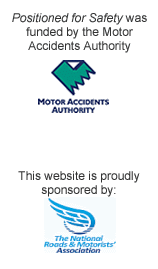Risk Factors
Road user behaviour is generally considered to be the most significant contributor to any road crash. Speed, alcohol and fatigue together with use of seatbelts and helmets are the main focus of most road safety campaigns.
In 2010 8% of motorcycle riders involved in fatal crashes had illegal blood alcohol. Over half of fatal motorcycle crashes were associated with excessive speed (52%) and 11% with fatigue. However these factors account for less than one third of all non-fatal injury crashes. There are a range of other less easily documented factors which also play a part in road crashes. These include rider and driver attitude and attention to the task as well as poor habits such as failing to check mirrors and over the shoulder before changing lanes or driving too close to the vehicle in front. There are also various forms of distraction particularly for drivers, such as eating, smoking, changing radio stations or cds and using mobile phones, all of which may also contribute to crashes.
A recent study found that drivers speaking on a mobile phone were more dangerous than drivers with an illegal blood alcohol level. While hands free phones were marginally safer than hand held, even drivers with hands free phones still missed significantly more road warning signs than when drunk. The researchers concluded that the danger is not due to steering with one hand, but to the divided attention while speaking on a phone (Direct Line Motor Insurance, Mobile Phone Report, 2002). The increasing use by riders of in-helmet communication systems such as mobile phones and music systems has yet to be assessed but seems likely to present similar risks.
The key risk factors associated with motorcycle crashes are:
The table below shows the proportion of NSW motorcycle crashes that were associated with one of these factors between 2006-10. The table distinguishes between licensed and unlicensed riders and those whose license status was unknown. For example, 5% of riders in crashes had illegal alcohol levels, but these included only 4% of licensed riders where as 23% of unlicensed and 8% of those with unknown status had illegal alcohol levels.
| Rider factors in crashes | All riders in crashes (n=13,482) | Learners (n=1,638) | Provisional (n=1,060) | Full licence (n=7,569) | Unlicensed (n=904) | Unknown licence status (n=1,747) |
| All crashes | 100% | 12% | 8% | 56% | 7% | 13% |
| Fatal crashes | 100% | 6% | 5% | 65% | 21% | 1% |
| Rider at fault | 38% | 38% | 36% | 34% | 57% | 46% |
| Under 26 years | 28% | 66% | 61% | 12% | 55% | 30% |
| Over 40 years | 34% | 8% | 6% | 47% | 15% | 25% |
| Fatigue | 7% | 6% | 5% | 5% | 13% | 9% |
| Speed | 24% | 22% | 20% | 23% | 30% | 24% |
| Alcohol | 3.8% | 4.0% | 1.6% | 2.3% | 17.6% | 4.1% |
| Casualty without helmet | 2.8% | 0.5% | 1.3% | 0.3% | 18.4% | 9.1% |
-
Unlicensed riders
High risk behaviour The majority of riders (56%) involved in crashes hold standard licences. Over the past 5 years, only 7% of riders in crashes were unlicensed or disqualified. But these 904 riders...
-
Aged under 26
Young people are less likely to own a motorcycle, but those who do are relatively more likely to be involved in crashes. However the situation for young riders does appear to be improving. The graph...
-
Fatigue
Motorcyclists are more likely to be involved in a crash on a weekend than on a weekday. Between 2006-10, 23% more motorcycle crashes including 47% of all fatal crashes occurred on a weekend rather...
-
Speeding
Speeding is very common amongst all motorists. RTA speed surveys show that in 60 km/hr zones nearly one in five drivers exceed the speed limit by 10 km/h or more. In 100 km/h zones the proportion is...
-
Alcohol
Drink driving/ riding is a primary cause of road deaths in Australia. In NSW, alcohol was involved in 19% of all fatal vehicle crashes and 13% of fatal motorcycle crashes between 2003-2007. Most...

